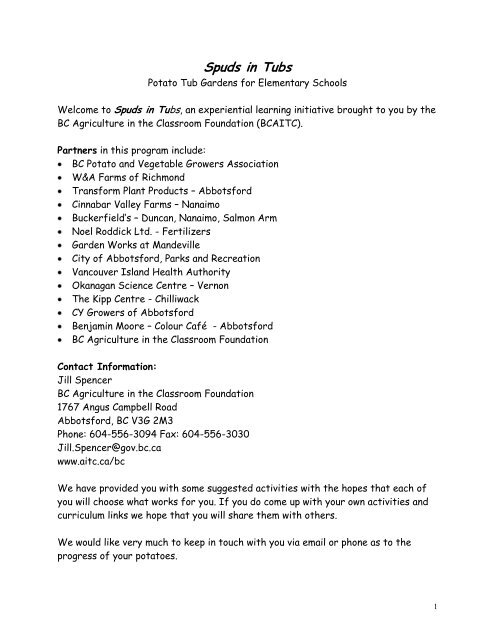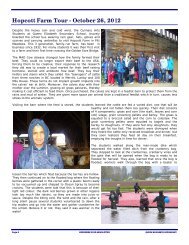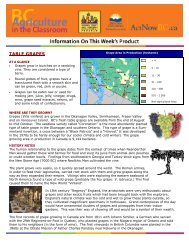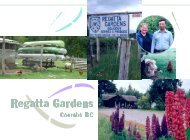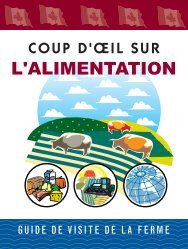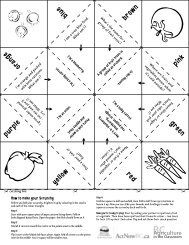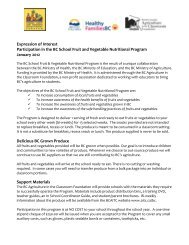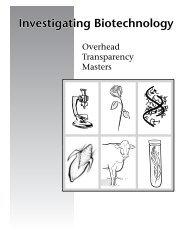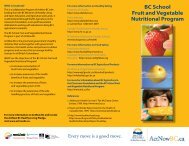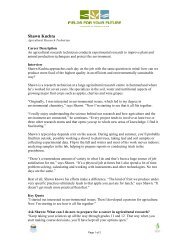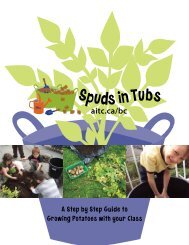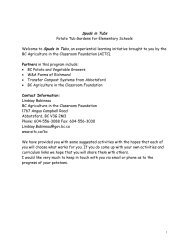Spuds in Tubs - agriculture in the classroom...
Spuds in Tubs - agriculture in the classroom...
Spuds in Tubs - agriculture in the classroom...
Create successful ePaper yourself
Turn your PDF publications into a flip-book with our unique Google optimized e-Paper software.
<strong>Spuds</strong> <strong>in</strong> <strong>Tubs</strong><br />
Potato Tub Gardens for Elementary Schools<br />
Welcome to <strong>Spuds</strong> <strong>in</strong> <strong>Tubs</strong>, an experiential learn<strong>in</strong>g <strong>in</strong>itiative brought to you by <strong>the</strong><br />
BC Agriculture <strong>in</strong> <strong>the</strong> Classroom Foundation (BCAITC).<br />
Partners <strong>in</strong> this program <strong>in</strong>clude:<br />
BC Potato and Vegetable Growers Association<br />
W&A Farms of Richmond<br />
Transform Plant Products – Abbotsford<br />
C<strong>in</strong>nabar Valley Farms – Nanaimo<br />
Buckerfield’s – Duncan, Nanaimo, Salmon Arm<br />
Noel Roddick Ltd. - Fertilizers<br />
Garden Works at Mandeville<br />
City of Abbotsford, Parks and Recreation<br />
Vancouver Island Health Authority<br />
Okanagan Science Centre – Vernon<br />
The Kipp Centre - Chilliwack<br />
CY Growers of Abbotsford<br />
Benjam<strong>in</strong> Moore – Colour Café - Abbotsford<br />
BC Agriculture <strong>in</strong> <strong>the</strong> Classroom Foundation<br />
Contact Information:<br />
Jill Spencer<br />
BC Agriculture <strong>in</strong> <strong>the</strong> Classroom Foundation<br />
1767 Angus Campbell Road<br />
Abbotsford, BC V3G 2M3<br />
Phone: 604-556-3094 Fax: 604-556-3030<br />
Jill.Spencer@gov.bc.ca<br />
www.aitc.ca/bc<br />
We have provided you with some suggested activities with <strong>the</strong> hopes that each of<br />
you will choose what works for you. If you do come up with your own activities and<br />
curriculum l<strong>in</strong>ks we hope that you will share <strong>the</strong>m with o<strong>the</strong>rs.<br />
We would like very much to keep <strong>in</strong> touch with you via email or phone as to <strong>the</strong><br />
progress of your potatoes.<br />
1
<strong>Spuds</strong> <strong>in</strong> <strong>Tubs</strong><br />
L<strong>in</strong>ks to <strong>the</strong> British Columbia Science Curriculum<br />
Learn<strong>in</strong>g Outcomes for Grades K – 6<br />
“All Canadian students. . . should have opportunities to develop scientific literacy.<br />
Scientific literacy is an evolv<strong>in</strong>g comb<strong>in</strong>ation of <strong>the</strong> science-related attitudes; skills<br />
and knowledge students need to:<br />
Develop <strong>in</strong>quiry, problem solv<strong>in</strong>g, and decision-mak<strong>in</strong>g abilities as citizens<br />
Become lifelong learners<br />
Ma<strong>in</strong>ta<strong>in</strong> a sense of wonder about <strong>the</strong> world around <strong>the</strong>m”.<br />
(From <strong>the</strong> Science K to 7 Integrated Resource Package 2005, BC M<strong>in</strong>istry of Education,<br />
page 11)<br />
K<strong>in</strong>dergarten<br />
- describe features of local plants (e.g., colour, shape, size, texture)<br />
- compare local plants<br />
- demonstrate <strong>the</strong> ability to observe <strong>the</strong>ir surround<strong>in</strong>gs<br />
- describe features of <strong>the</strong>ir immediate environment<br />
- use <strong>the</strong> five senses to make observations<br />
- share with o<strong>the</strong>rs <strong>in</strong>formation obta<strong>in</strong>ed by observ<strong>in</strong>g<br />
Grade 1<br />
- classify liv<strong>in</strong>g and non-liv<strong>in</strong>g th<strong>in</strong>gs<br />
- describe <strong>the</strong> basic needs of local plants (e.g., food, water, light)<br />
- describe how <strong>the</strong> basic needs of plants are met <strong>in</strong> <strong>the</strong>ir environment<br />
- describe changes that occur <strong>in</strong> daily and seasonal cycles and <strong>the</strong>ir effect<br />
on liv<strong>in</strong>g th<strong>in</strong>gs<br />
- communicate <strong>the</strong>ir observations, experiences, and th<strong>in</strong>k<strong>in</strong>g <strong>in</strong> a variety of<br />
ways (e.g., verbally, pictorially, graphically)<br />
Grade 2<br />
- describe physical properties of air, water, and soil<br />
- dist<strong>in</strong>guish ways <strong>in</strong> which air, water, and soil <strong>in</strong>teract<br />
- expla<strong>in</strong> why air, water, and soil are important for liv<strong>in</strong>g th<strong>in</strong>gs<br />
- use <strong>the</strong>ir senses to <strong>in</strong>terpret observations<br />
- <strong>in</strong>fer <strong>the</strong> probable outcome of an event or behaviour based on observations<br />
2
Grade 3<br />
- compare familiar plants accord<strong>in</strong>g to similarities and differences <strong>in</strong> appearance<br />
and life cycles<br />
- ask questions that foster <strong>in</strong>vestigations and explorations relevant to <strong>the</strong> content<br />
- measure objects and events<br />
Grade 4<br />
- compare <strong>the</strong> structures of local plants <strong>in</strong> different habitats<br />
- analyse impacts of wea<strong>the</strong>r on liv<strong>in</strong>g th<strong>in</strong>gs<br />
- make predictions, supported by reasons and relevant to <strong>the</strong> content<br />
- use data from <strong>in</strong>vestigations to recognize patterns and relationships and reach<br />
conclusions<br />
Grade 5<br />
- analyse how BC’s liv<strong>in</strong>g resources are used<br />
- identify methods of harvest<strong>in</strong>g and process<strong>in</strong>g BC’s resources<br />
- describe potential environmental impacts of us<strong>in</strong>g BC’s liv<strong>in</strong>g resources<br />
- identify variables that can be changed <strong>in</strong> an experiment<br />
- evaluate <strong>the</strong> fairness of a given experiment<br />
- describe <strong>the</strong> steps <strong>in</strong> design<strong>in</strong>g an experiment<br />
Grade 6<br />
- demonstrate <strong>the</strong> appropriate use of tools to exam<strong>in</strong>e liv<strong>in</strong>g th<strong>in</strong>gs that cannot be<br />
seen with <strong>the</strong> naked eye<br />
- analyse how different organisms adapt to <strong>the</strong>ir environments<br />
- manipulate and control a number of variables <strong>in</strong> an experiment<br />
- apply solutions to a technical problem (e.g., malfunction<strong>in</strong>g electrical circuit)<br />
Additional Information and Resources<br />
www.potato2008.org<br />
3
<strong>Spuds</strong> <strong>in</strong> <strong>Tubs</strong><br />
Objective<br />
As part of science, social studies and now healthy liv<strong>in</strong>g it has been brought to our<br />
attention that many schools would like to grow food at <strong>the</strong> school but f<strong>in</strong>d it<br />
difficult to work with <strong>in</strong>ground school gardens. As a solution BCAITC has developed<br />
potato tub gardens that will allow students to grow and eat nugget potatoes with<strong>in</strong><br />
<strong>the</strong> conf<strong>in</strong>es of <strong>the</strong> school calendar.<br />
Materials provided with <strong>Spuds</strong> <strong>in</strong> <strong>Tubs</strong>:<br />
6 large black nursery tubs<br />
15 20 litre bags of special potato grow<strong>in</strong>g compost<br />
25 plus Warba seed potatoes<br />
12 packages of <strong>Spuds</strong> <strong>in</strong> <strong>Tubs</strong> Potato Plant Food – organic based<br />
One plastic drop sheet<br />
1 AITC ruler<br />
Grow BC map<br />
CD – Close to Home<br />
Related BC Ag <strong>in</strong> <strong>the</strong> Classroom Unit Plan<br />
Procedure:<br />
Late February to early March:<br />
Leave seed potatoes <strong>in</strong> <strong>the</strong>ir special bag to encourage sprout<strong>in</strong>g <strong>in</strong> your warm<br />
<strong>classroom</strong>.<br />
When <strong>the</strong> seed potatoes have shoots that are about 2cm <strong>in</strong> length it is time to<br />
plant <strong>the</strong> potatoes. The potatoes must be planted before Spr<strong>in</strong>g Break. If your<br />
spuds have not sprouted, plant <strong>the</strong>m anyway. If you have a seed potato with so<br />
many sprouts that it seems “hairy”, do not plant that seed potato.<br />
Plant<strong>in</strong>g<br />
S<strong>in</strong>ce <strong>the</strong> tubs are portable, potatoes can be planted <strong>in</strong> <strong>the</strong>ir tubs ei<strong>the</strong>r <strong>in</strong> <strong>the</strong><br />
<strong>classroom</strong> or some o<strong>the</strong>r place <strong>in</strong>side <strong>the</strong> school.<br />
Remember: If you are plant<strong>in</strong>g <strong>in</strong>side <strong>the</strong>n be sure to protect <strong>the</strong> floor with <strong>the</strong><br />
drop sheet provided as <strong>the</strong> tubs do have dra<strong>in</strong>age holes.<br />
Empty one bag of compost <strong>in</strong>to each of <strong>the</strong> 6 tubs provided. Spr<strong>in</strong>kle one bag of<br />
Potato Plant Food evenly over <strong>the</strong> compost and gently work it <strong>in</strong>to <strong>the</strong> compost.<br />
4
Place 5 seed potatoes evenly around <strong>the</strong> outside of <strong>the</strong> tub, sprouts up and about 10<br />
cm from <strong>the</strong> outside edge. Cover <strong>the</strong> potatoes with compost.<br />
X<br />
X<br />
X<br />
X<br />
X<br />
Hill<strong>in</strong>g:<br />
Potatoes are produced on <strong>the</strong> stems of <strong>the</strong> potato plant. The more stem that comes<br />
<strong>in</strong> contact with <strong>the</strong> compost, <strong>the</strong> more potatoes <strong>the</strong>y will produce.<br />
As <strong>the</strong> leaves of <strong>the</strong> new plants push up through <strong>the</strong> compost it is important to<br />
keep <strong>the</strong> stems covered with compost. As <strong>the</strong> plants keep grow<strong>in</strong>g add additional<br />
compost at regular <strong>in</strong>tervals until <strong>the</strong> tub is filled to <strong>the</strong> top and <strong>the</strong> leaves are<br />
over <strong>the</strong> top of <strong>the</strong> pot. Always leave at least a few leaves show<strong>in</strong>g.<br />
When <strong>the</strong> new plants are about 15 cm high it will be time to place <strong>the</strong>m outside <strong>in</strong> a<br />
sunny well-protected area of <strong>the</strong> school grounds. Try to f<strong>in</strong>d a south fac<strong>in</strong>g wall<br />
that will help absorb <strong>the</strong> heat and light from <strong>the</strong> sun. The spuds should not be<br />
exposed to <strong>the</strong> w<strong>in</strong>d, so <strong>the</strong> area should also be <strong>in</strong> a protected location. If such a<br />
place is not available, perhaps a neighbor will keep <strong>the</strong>m on <strong>the</strong>ir property. It is<br />
always good to get out for a walk to see <strong>the</strong> spuds!<br />
Water<strong>in</strong>g<br />
Your potatoes will require occasional water<strong>in</strong>g. You can tell if <strong>the</strong> tubs are dry by<br />
ei<strong>the</strong>r feel<strong>in</strong>g <strong>the</strong> compost with your f<strong>in</strong>gers or not<strong>in</strong>g if <strong>the</strong> compost is pull<strong>in</strong>g away<br />
from <strong>the</strong> side of <strong>the</strong> tub. Wilted potatoes will slow down production.<br />
Feed<strong>in</strong>g<br />
You have been provided with 2 packages of <strong>Spuds</strong> <strong>in</strong> <strong>Tubs</strong> Potato Plant Food for<br />
each tub. Carefully and thoroughly mix one package of plant food <strong>in</strong> <strong>the</strong> tub with<br />
<strong>the</strong> compost at <strong>the</strong> time of plant<strong>in</strong>g. Save <strong>the</strong> second package for later on after you<br />
have completely hilled your potatoes and <strong>the</strong>y are safely outside. At this time,<br />
spr<strong>in</strong>kle <strong>the</strong> rema<strong>in</strong><strong>in</strong>g plant food on <strong>the</strong> top of <strong>the</strong> compost and gently scratch <strong>the</strong><br />
surface to work <strong>the</strong> fertilizer <strong>in</strong>to <strong>the</strong> compost. Water well.<br />
The potato plants will grow tall and green and will fill out to cover <strong>the</strong> tubs.<br />
5
Harvest<br />
In early June <strong>the</strong> plants will die back and it will be time to harvest <strong>the</strong> potatoes.<br />
Have students carefully dig up <strong>the</strong>ir potato plants try<strong>in</strong>g to keep <strong>the</strong>ir potatoes<br />
attached (<strong>the</strong> nugget potatoes are actually a modified stem).<br />
See if students can f<strong>in</strong>d <strong>the</strong>ir orig<strong>in</strong>al seed potato. What does it look like now<br />
Have students count <strong>the</strong> number of nugget potatoes from each of <strong>the</strong>ir plants and<br />
compare to o<strong>the</strong>r tubs. If possible weigh <strong>the</strong> total harvest. Imag<strong>in</strong>e what can be<br />
grown <strong>in</strong> an entire field!<br />
Once <strong>the</strong> potatoes are harvested <strong>the</strong> grow<strong>in</strong>g compost can be added to exist<strong>in</strong>g<br />
shrub beds around <strong>the</strong> school and <strong>the</strong> tubs washed and put away until next spr<strong>in</strong>g.<br />
Eat<strong>in</strong>g<br />
Wash carefully and <strong>the</strong>n steam or boil your potatoes <strong>in</strong> <strong>the</strong> school kitchen. Add a<br />
little fresh butter and serve <strong>the</strong>m to your students, parents or o<strong>the</strong>r teachers.<br />
Enjoy <strong>the</strong> feel<strong>in</strong>g of grow<strong>in</strong>g your own food and enjoy <strong>the</strong> taste of really fresh<br />
potatoes! Keep <strong>the</strong> potatoes warm <strong>in</strong> a crock pot if you need to delay eat<strong>in</strong>g. Invite<br />
your student’s parents!<br />
Activities – Before Plant<strong>in</strong>g<br />
Record number and colour of seed potatoes<br />
Record total weight of seed potatoes<br />
Record number of days to full 2 cm sprouts<br />
Record number and colour of sprouts per potato/overall for <strong>the</strong> class<br />
Observe and record any changes <strong>in</strong> <strong>the</strong> seed potato sk<strong>in</strong> as <strong>the</strong> sprout grows<br />
Cut and make observations of extra seed potatoes or any that do not sprout<br />
Have students dist<strong>in</strong>guish between a seed, corm, bulb and tuber<br />
Compost<br />
1) From <strong>the</strong> empty compost bag provided make up a list of 10 vocabulary words and<br />
f<strong>in</strong>d def<strong>in</strong>itions ie: nutrients, compost, pH, organic etc.<br />
2) Open one bag of compost. Record observations about <strong>the</strong> colour, texture, and<br />
smell of <strong>the</strong> compost.<br />
What is <strong>the</strong> volume of material found <strong>in</strong> <strong>the</strong> compost bag<br />
How many bags will it take to fill one tub<br />
6
Grow<strong>in</strong>g<br />
Observations<br />
Record and graph <strong>the</strong> height of <strong>the</strong> plants to <strong>the</strong> number of days<br />
Observe <strong>the</strong> leaves – colour, shape, ve<strong>in</strong>s etc. Do leaf rubb<strong>in</strong>gs.<br />
Record number of sunny days, sunrise and sunset, watch how <strong>the</strong> days are<br />
gett<strong>in</strong>g longer, average temperature, frost etc.<br />
Record <strong>the</strong> number of days that your plants are <strong>in</strong> <strong>the</strong> tubs.<br />
Extension<br />
F<strong>in</strong>d out more about Warba potatoes and o<strong>the</strong>r potato varieties.<br />
Research <strong>the</strong> history of <strong>the</strong> potato from ancient times.<br />
F<strong>in</strong>d out how potatoes are grown and harvested <strong>in</strong> <strong>the</strong> field.<br />
Us<strong>in</strong>g <strong>the</strong> map of BC f<strong>in</strong>d out where potatoes are grown.<br />
Try to sprout nugget potatoes from <strong>the</strong> grocery store.<br />
Research <strong>the</strong> value of potatoes to a healthy diet.<br />
Share recipes.<br />
Why <strong>the</strong> Potato<br />
In <strong>the</strong> space of just 400 years, <strong>the</strong> potato has become a staple crop of many people around <strong>the</strong><br />
world whose ancestors had subsisted perfectly well upon gra<strong>in</strong> crops for anyth<strong>in</strong>g up to 4000 years.<br />
The reason for this somewhat surpris<strong>in</strong>g development is that <strong>the</strong> potato is <strong>the</strong> best all-around<br />
bundle of nutrition known to mank<strong>in</strong>d.<br />
Its ratio of carbohydrate to prote<strong>in</strong> is such that anyone eat<strong>in</strong>g enough potatoes to satisfy <strong>the</strong>ir<br />
energy requirements will automatically obta<strong>in</strong> most of <strong>the</strong> prote<strong>in</strong> <strong>the</strong>y require. Potatoes also<br />
conta<strong>in</strong> significant amounts of essential vitam<strong>in</strong>s (<strong>the</strong> British, <strong>in</strong> fact, used to derive 30% of <strong>the</strong>ir<br />
vitam<strong>in</strong> C <strong>in</strong>take from potatoes.)<br />
Exceptional productivity is ano<strong>the</strong>r virtue of <strong>the</strong> potato. A field of potatoes produces more energy<br />
per hectare per day than a field of any o<strong>the</strong>r crop. Potatoes grow well from sea level to 14,000 feet<br />
on a wider variety of soils, under a wider range of climatic conditions, than any o<strong>the</strong>r staple food.<br />
The potato matures <strong>in</strong> 90 to 120 days, and will provide small but edible tubers <strong>in</strong> just 60 days. All <strong>in</strong><br />
all, <strong>the</strong> potato is about <strong>the</strong> world's most efficient means of convert<strong>in</strong>g plant, land, water and labour<br />
<strong>in</strong>to a palatable and nutritious food.<br />
John Reader, Man on Earth, 1998<br />
7
The Liv<strong>in</strong>g Potato Gallery<br />
Potato Plants: In this picture <strong>the</strong> potato tubers have been exposed. Normally <strong>the</strong><br />
tubers and roots would be underground.<br />
8


